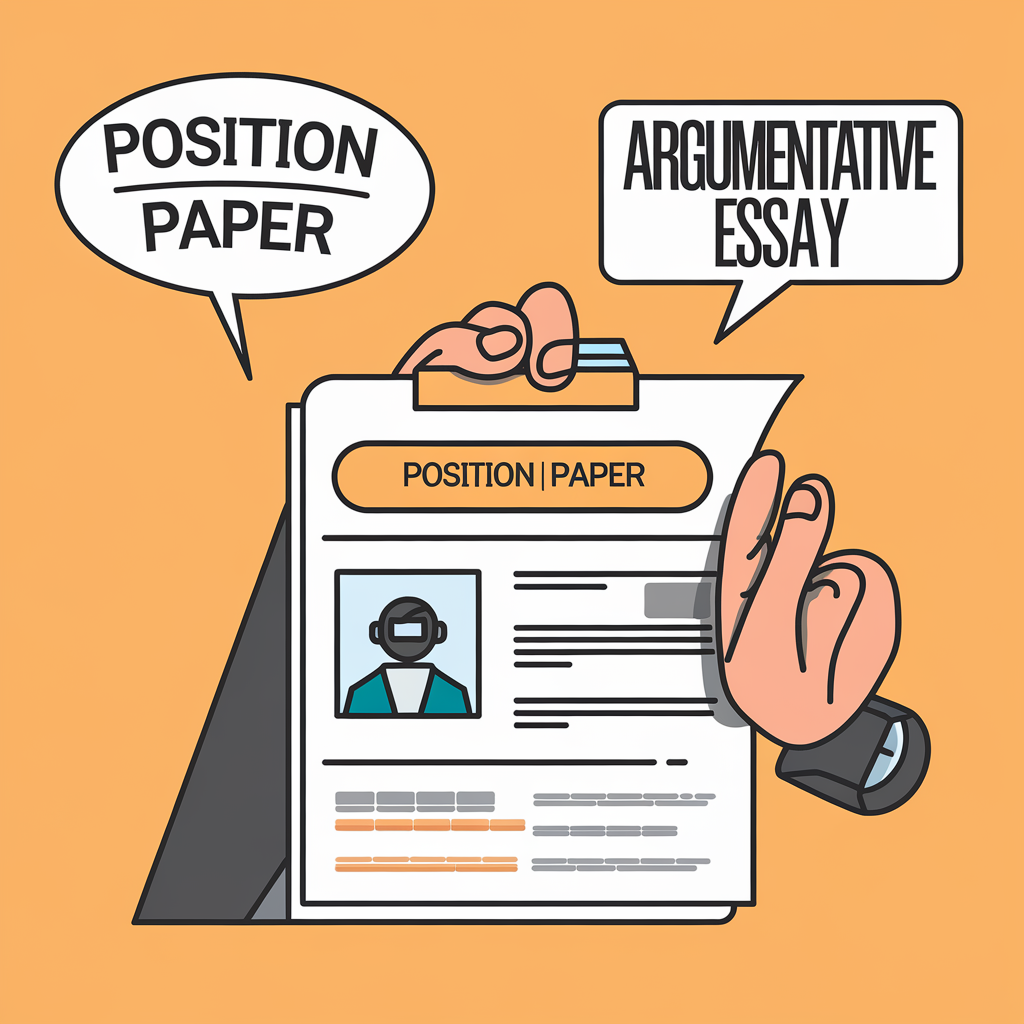A position paper and an argumentative essay require writers to present and support a viewpoint with evidence. However, they differ in purpose, structure, audience, and tone. These differences influence how information is conveyed, the depth of analysis required, and how arguments are framed.
Whether you are writing for an academic course, a policy discussion, or a public debate, knowing when to use each format can improve the effectiveness of your writing.
1. Purpose: Informing vs. Persuading
Position Paper: Presenting a Well-Informed Stance
A position paper aims to inform readers about a particular issue and advocate for a specific stance. Rather than simply arguing one side, it provides a nuanced, well-researched analysis of the problem, acknowledging different perspectives before proposing a solution or recommending a course of action.
-
Where Position Papers Are Used:
- Policy discussions
- Government and organizational reports
- Academic and research conferences
- Debate and Model UN competitions
-
Example: A policy paper advocating for adopting renewable energy in urban areas. It would outline the economic, environmental, and social implications, discuss alternative viewpoints (e.g., concerns over infrastructure costs), and provide a recommended course of action, such as increased government subsidies.
Argumentative Essay: Convincing the Audience
An argumentative essay primarily seeks to persuade the reader to agree with a particular viewpoint. Unlike a position paper, which explores multiple perspectives in depth, an argumentative essay is more direct and assertive, focusing on proving that one side is stronger than the other.
-
Where Argumentative Essays Are Used:
- Academic essays (college and high school)
- Opinion columns and editorials
- Legal arguments and debates
- Persuasive speeches
-
Example: A student writing an essay titled “Why Renewable Energy Is the Future” would focus on convincing the audience of the benefits of renewable energy while refuting opposing views. It may use emotional appeals, statistics, and logical reasoning to build a strong case.

2. Structural Differences: Analytical vs. Persuasive Organization
Both formats follow a structured approach but differ in how they present information.
| Feature |
Position Paper |
Argumentative Essay |
| Introduction |
Provides background, explains key terms, and clearly states the position. |
States a clear thesis that presents the argument concisely. |
| Body Paragraphs |
Examines multiple perspectives before supporting a stance; includes historical context, case studies, and policy analysis. |
Uses persuasive reasoning and evidence to prove why one viewpoint is correct. |
| Counterarguments |
Discusses opposing viewpoints in detail, weighing their merits before explaining why a particular stance is preferable. |
Mentions counterarguments mainly to refute them and strengthen the primary argument. |
| Conclusion |
Summarizes key points and often provides policy recommendations or suggested actions. |
Restates the thesis and main arguments to leave a lasting impression. |
3. Audience: Who Reads These Papers?
Position Paper: Decision-Makers and Informed Readers
A position paper is often intended for an audience with some knowledge of the topic. The purpose is to present a well-rounded analysis that policymakers, professionals, or academics can use to make informed decisions.
- Examples of Position Paper Audiences:
- Government officials assessing proposed policies
- Business executives evaluating industry trends
- Conference attendees discussing research findings
Argumentative Essay: A Broader Audience with Varying Perspectives
Argumentative essays are often written for a general audience that may not be familiar with the topic. The goal is to convince readers through logical reasoning, emotional appeals, and persuasive rhetoric.
- Examples of Argumentative Essay Audiences:
- Teachers and professors grading student essays
- General readers engaging with newspaper editorials
- Debate audiences evaluating competing arguments
4. Tone and Style: Diplomatic vs. Assertive
Position Paper: Formal and Diplomatic
Since position papers often target policymakers, professionals, or academic readers, they maintain a formal, balanced, and objective tone. They strive to acknowledge opposing viewpoints rather than dismissing them outright.
- Example Statement in a Position Paper:
“While some critics argue that the initial costs of renewable energy are too high, long-term benefits such as energy independence and reduced carbon emissions make a compelling case for increased investment.”
Argumentative Essay: Assertive and Persuasive
An argumentative essay is more persuasive and direct, often using rhetorical devices, emotional appeals, and strong assertions to convince readers.
- Example Statement in an Argumentative Essay:
“If we fail to transition to renewable energy now, we are condemning future generations to an environmental disaster fueled by short-term greed.”
5. When to Use Each Format?
6. Strengthening Your Writing: Best Practices
For Position Papers:
- Cite credible sources (e.g., government reports, peer-reviewed research) to support your analysis.
- Present multiple viewpoints fairly before advocating for your position.
- Use data, case studies, and real-world examples to strengthen credibility.
For Argumentative Essays:
- Develop a strong thesis statement that takes a clear stance.
- Use persuasive language and rhetorical techniques such as logos (logic), ethos (credibility), and pathos (emotion).
- Anticipate counterarguments and refute them effectively.
7. Further Reading & Resources
For more guidance on writing position papers and argumentative essays, consider these resources:
Final Thoughts
Both position papers and argumentative essays require critical thinking and strong evidence-based writing, but they serve different purposes. By understanding the differences in tone, structure, and intent, writers can choose the right format for their goals and audience.









 Evan John
Evan John